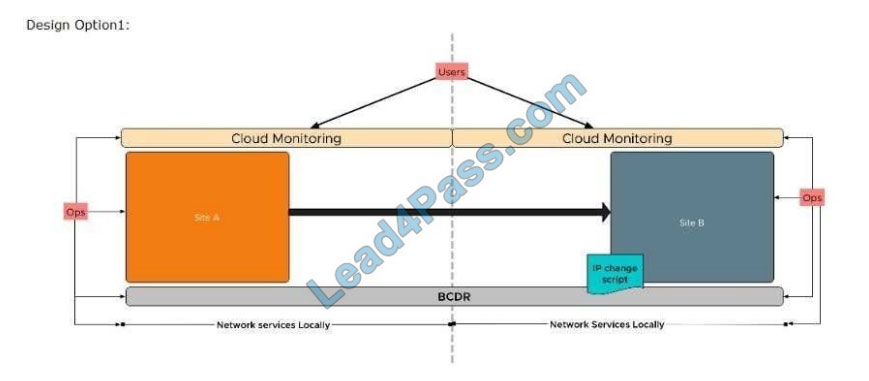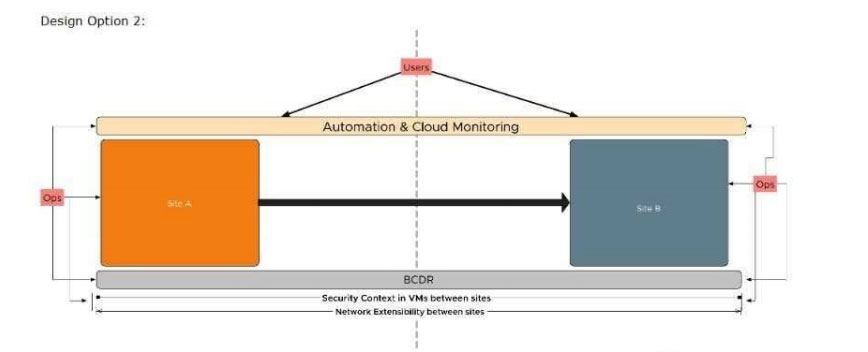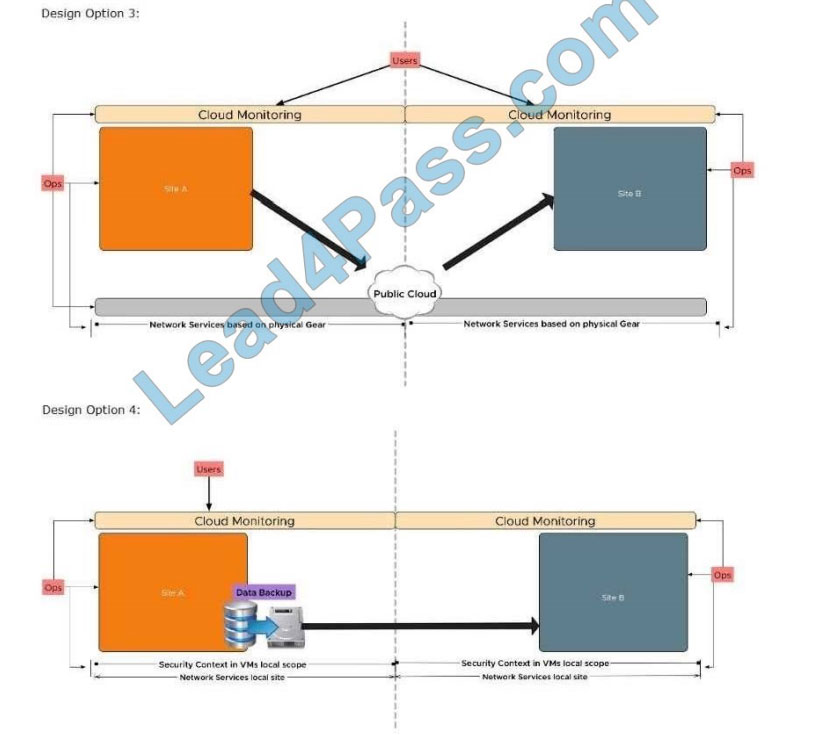The latest VMware 3v0-41.19 dumps by leads4pass helps you pass the 3v0-41.19 exam for the first time! leads4pass
Latest Update VMware 3v0-41.19 VCE Dump and 3v0-41.19 PDF Dumps, leads4pass 3v0-41.19 Exam Questions Updated, Answers corrected!
Get the latest leads4pass 3v0-41.19 dumps with Vce and PDF: https://www.leads4pass.com/3v0-41-19.html (Q&As: 50 dumps)
[Free 3v0-41.19 PDF] Latest VMware 3v0-41.19 Dumps PDF collected by leads4pass Google Drive:
https://drive.google.com/file/d/1cmlZxEN5EnXp17Sv7E6Mke9OsOA8HvEa/
[leads4pass 3v0-41.19 Youtube] VMware 3v0-41.19 Dumps can be viewed on Youtube shared by leads4pass
Latest VMware 3v0-41.19 Exam Practice Questions and Answers
QUESTION 1
An architect is helping an organization design an NSX-T Data Center solution. This information was gathered during a
workshop:
1.
There are three LUNs In the storage array.
2.
There is no additional budget to purchase any more hardware.
3.
LUN 1 usage is 90% and is configured with a high-performance profile.
4.
LUN 2 usage is 75% and is configured with a high availability profile.
5.
LUN 3 usage is 60% and is configured with a balanced performance/availability profile.
6.
A highly available NSX Management cluster is required.
7.
ECMP routing is required.
Which should the architect recommend for the organization\\’s NSX-T Datacenter environment?
A. Place all three NSX Managers on LUN 2 for high availability.
B. Place all three NSX Managers on LUN 1 to avoid latency.
C. Spread the NSX Managers across LUN 2 and LUN 3.
D. Spread the NSX Managers across the three LUNs.
Correct Answer: D
Even though the LUN itself is “HA”, the fact remains it is an S.P.o.F. and must not have all the managers running on it.
While (C) seems fine, because LUN2 is “HA”, if either LUN goes offline that holds 2 managers then you have lost
quorum and will effectively be down w/o an mgmt. cluster.
QUESTION 2
An architect is helping an organization with the Logical Design of an NSX-T Data Center solution. This information was
gathered during the assessment: There must be a performance-based SLA for East-West traffic.
Which two key performance features should the architect recommend? (Choose two.)
A. Setup RSS to leverage multiple cores.
B. Enable GENEVE-Offload.
C. Configure N-VDS Enhanced Data Path.
D. Install advanced Edge pNIC Features.
E. Leverage DPDK drivers.
Correct Answer: AB
*
(D) is wrong because it’s talking about edge pNIC and the only requirement we have shows performance-based SLA for
East/West traffic.
*
(E) is wrong because DPDK is about edge fast-path for bare-metal NSX-T Edges
*
(A, B, and C) are all perf enhancers
*
(C) is focused on super-low latency for NFV type workloads; if its not needed then don\\’t deploy it.
*
(B) GENEVE-Offload (TSO for Geneve offload send and LRO for Geneve offload receive)uses Rx/Tx filters for queuing
traffic.
*
(A) seems like the next best option over (C) as it corresponds to offloading principles of RSS, TSO, and LRO
https://www.virtualizationhowto.com/2019/10/vmware-nsx-t-performance-tips-and-tuning/
QUESTION 3
Which type of design includes vendor models, hostnames, IP Addresses, port connections, logical unit number sizes,
and number of CPUs?
A. High-Level Design
B. Physical Design
C. Logical Design
D. Conceptual Design
Correct Answer: B
https://www.jeffreykusters.nl/2018/06/25/breaking-down-the-conceptual-design-rcars-and-amprs-vcdx-style/
QUESTION 4
An architect is helping an organization with the Logical Design of an NSX-T Data Center solution. This information was
gathered during the Assessment Phase:
1. Customer Is concerned with NSX Manager availability.
2.
3 cabinets/racks are available in the data center.
3.
No integration with 3rd party solution is required.
4.
There is no budget for physical equipment acquisition.
5.
The 3 cabinets/racks do not share the same L2 domain.
Which three should the architect include in their design to address the customer\\’s concern with NSX Manager
availability? (Choose three.)
A. Use another NSX Manger IP in case an appliance falls.
B. Deploy 2 cold standby NSX Manager appliances in rack 2/3.
C. Deploy an NSX Manager Appliance per rack and cluster them.
D. Use a physical/internal load-balancer with the cluster.
E. Use separate IP per NSX Manager appliance per rack.
F. Deploy a single active NSX Manager appliance in rack 1.
Correct Answer: CDE
The customer is concerned with availability and NSX-T requires (except for labs)a 3x Mgr cluster must be deployed. You
can use internal HA/VIP and vSphere HA for the Mgmt cluster only when the mgrs. are on the same L2 domain. To do this
you
need an external load-balancer, the only one that would meet the “no 3rd party” and “no physical equipment acquisition”
would be an NSX-T Edge LB though the only answer that lines up with that is (D) and it’s worded poorly. (F) and (B) are
both
wrong/worded even more poorly. (A) by itself isn\\’t right/wrong but when also looking at (E) then you know it doesn\\’t
cut it. (C and E) are correct.
https://docs.vmware.com/en/VMware-NSX-T-DataCenter/2.4/installation/GUID-72A55651-0031-43A4-9F23-5950C1AFF304.html
https://vxplanet.com/2020/03/26/using-nsx-t-loadbalancer-for-the-nsx-t-management-cluster-part-1/
https://vxplanet.com/2020/03/26/using-nsx-t-loadbalancer-for-the-nsx-t-management-cluster-part-2/
QUESTION 5
An architect is helping an organization with the Conceptual Design of an NSX-T Data Center solution. This information
was gathered by the architect during the Discover Task of the Engagement Lifecycle:
1.
Existing hardware will be used In any design proposal.
2.
Network bandwidth cannot be expanded.
Which concept of the Discover Task do these items belong to?
A. requirement
B. risk
C. constraint
D. assumption
Correct Answer: C
QUESTION 6
An architect is helping an organization with the Logical Design of an NSX-T Data Center solution. During discussions
about Centralized Services NAT running on Tier-1 or Tier-0 LR the customer made these requests:
1.
Services contain stateful services.
2.
Services should be in high availability mode.
Which two should the architect include in their design? (Choose two.)
A. An active/active model should be used.
B. NAT should be applied on the uplink Interface.
C. Mix stateful and stateless NAT rules on the same LR.
D. The high availability mode supported is only Active-Standby.
E. Use only DNAT rules in stateful NAT.
Correct Answer: DE
1.
Stateful services cant be inactive/active, they need to be in Active/Standby
2.
SNAT and DNAT work with stateful services, reflexive NAT works with stateless
3.
NAT is applied to a logical switch, not an uplink. http://www.vexpertconsultancy.com/2019/12/nsx-t-configure-networkaddress-translation-nat/
QUESTION 7
Which is associated with the Discover Task of the Engagement Lifecycle?
A. Create and document logical and virtual design.
B. Gather and document requirements, assumptions, and constraints.
C. Build, deploy, implement, and test the design.
D. Measure performance against customer\\’s requirements.
Correct Answer: B
Discovery is part of the initial conceptual design (RRCA)
QUESTION 8
What would an architect recommend to a customer that wants to extend management to an additional data center
through Layer 2, but does not want to add additional NSX-T licensing?
A. Deploy a standalone Edge as the L2 VPN client.
B. Deploy a standalone NSX Controller.
C. Deploy a standalone NSX Manager.
D. Deploy a standalone Edge as the IPSec VPN.
Correct Answer: D
IPSec VPN is really your only way as you aren\\’t stretching layer 2 but instead just connecting networks securely.
(BandC) are not possible or not really in line with what’s being asked.
QUESTION 9
Which three must be taken into consideration when creating a Logical Design for a planned migration? (Choose three.)
A. A transport node can attach single VLAN transport zones with single N-VDS.
B. An N-VDS with the same name can be attached to both Overlay and VLAN transport zones.
C. An N-VDS can attach to both an Overlay and a VLAN transport zone to an N-VDS having different name/s.
D. An N-VDS can only attach to a single Overlay transport zone.
E. An N-VDS can only attach to a single VLAN transport zone.
F. An N-VDS can only attach to multiple VLAN transport nodes.
Correct Answer: BDF
Transport Zone 101 w/ NSX-T
QUESTION 10
An architect is helping an organization with the Logical Design of an NSX-T Data Center solution. This information was
gathered during the Assessment Phase:
1.
There Isn\\’t much budget available for a new off-shore site.
2.
The new site is decentralized and no communication with the main data center is required.
3.
The design will need to cater to availability, upgrades, and failure scenarios.
Which three should the architect recommend In their design? (Choose three.)
A. Collapse of the Management/Edge/Compute cluster.
B. A Shared Edge/Management cluster and one for Compute.
C. Separate the host’s physical NICs for VSS and N-VDS.
D. Install a minimum of 4 ESXi hosts On the site.
E. Make all pNICs part of N-VDS and VMKs will be migrated.
F. Install a minimum of 6 ESXi hosts on the site.
Correct Answer: ACD
Limited budget for the new site means collapsing of mgmt., edge, and compute provides the best value at the lowest cost. NSXT can fully operate with 4 ESXi hosts (no need for 6) as that is more a requirement of VCF/vSAN. Because you are
running NSX Edges you should run a vSS or vDS for vmkerneland edge traffic and an N-vDS for NSX-T overlays traffic.
Each vSwitch requiring its own set of pNics https://blogs.vmware.com/networkvirtualization/2018/10/flexibledeploymentoptions-for-nsx-t-edge-vm.html/
QUESTION 11
According to the Discover Task of the Engagement Lifecycle, which statement would be classified as a risk?
A. To retain certification to provide financial services to end customers, PCI-DSS audits need to be passed.
B. A merger and acquisition process was recently completed and new company on-boarding is not completed.
C. Due to existing contracts and purchase agreements, the existing server hardware needs to be re-used.
D. Enough power and cooling capacity is available in each rack in the data center.
Correct Answer: A
In the RRCA conceptual phase, the biggest risks are those that have a high chance, high impact, or a combination of
both. You can mitigate those risks, but they must still be called out. Technically every assumption in a design is a risk.
(D) could be an assumption, but it’s after the discovery phase so it could be an actual assessment. (C) is a constraint on
the surface, though when combined with other things could then also become a risk (B) is a risk, but is lacking major
impact.
QUESTION 12
Refer to the exhibits.
An architect is helping an organization with the Conceptual Design of an NSX-T Data Center solution. The conceptual design includes these requirements, assumptions, constraints, and risks:
1.
Critical applications must run across sites without changing the IP addresses.
2.
Business continuity and disaster recovery (BCDR) plans will leverage a second site running vSphere.
3.
RTO/RPO must be reduced for the recovery of applications on the secondary site.
4.
IT Teams require automation tools for configuration.
Which Conceptual Design would the architect recommend to the customer?



A. Design Option 3
B. Design Option 1
C. Design Option 2
D. Design Option 4
Correct Answer: C
Be careful of the letter answers not matching up to the design options.
*
(B) is wrong as d.option 1 is using an IP change script and that violates a req/const.
*
(D) is wrong as d.option 4 doesn\\’t have a dual-site bcdr plan but instead just shipping a backup to site B. This doesn\\’t
lends itself to reducing RTO/RPO
*
(A) is wrong as d.option 3 has network services based on physical gear but then using the public cloud for part of its BCDR
strategy. It also has no automation solution as part of the design overview.
QUESTION 13
An architect is helping an organization with the Physical Design of an NSX-T Data Center solution.
1.
This information was gathered during a workshop:
2.
Some workloads should be moved to a Cloud Provider.
3.
Extend network\\’s VLAN or VNI across sites on the same broadcast domain.
4.
Enable VM mobility use cases such as migration and disaster recovery without IP address changes.
5.
Support 1500 byte MTU between sites.
Which should the architect include in their design?
A. SSL VPN
B. Reflexive NAT
C. L2 VPN
D. Load Balancer
Correct Answer: C
NSX-T doesn\\’t support SSL VPN, reflexive NATand LB don\\’t solve the ask. L2VPN will stretch across sites and to Cloud
Providers.
latest updated VMware 3v0-41.19 exam questions from the leads4pass 3v0-41.19 dumps! 100% pass the 3v0-41.19 exam!
Download leads4pass 3v0-41.19 VCE and PDF dumps: https://www.leads4pass.com/3v0-41-19.html (Q&As: 50 dumps)
Get free VMware 3v0-41.19 dumps PDF online: https://drive.google.com/file/d/1cmlZxEN5EnXp17Sv7E6Mke9OsOA8HvEa/